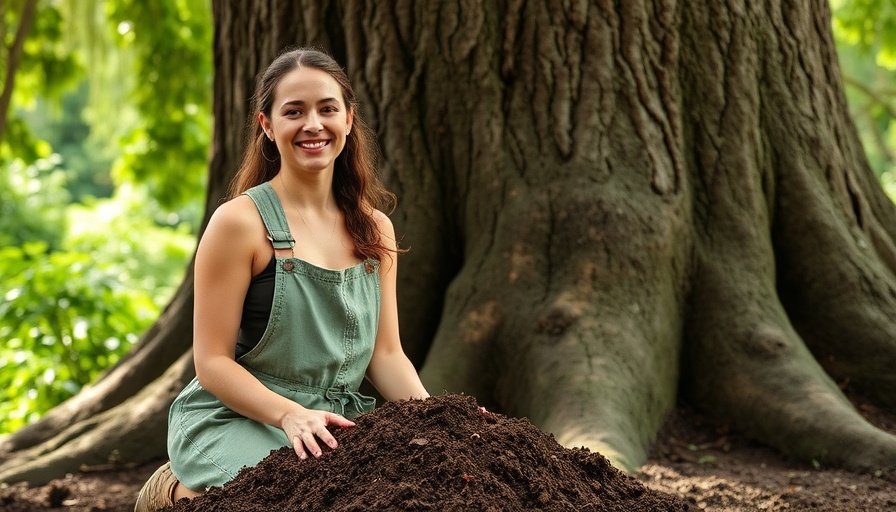
Why Mulching Matters in Spring Gardening
As spring rolls around, gardeners everywhere begin to prepare their landscapes for the vibrant season ahead. A crucial aspect of this preparation is mulching, a simple yet effective way to enhance soil quality, conserve moisture, and suppress weeds. Yet, many gardeners face challenges in understanding the best practices for mulching. By using mulch wisely, you can not only boost the visual appeal of your garden but also create a healthy environment for your plants to thrive.
In "Mulching tips to get your garden ready for spring 🌱🙌 #Shorts," the video highlights fundamental practices in gardening, encouraging a deeper analysis of mulching techniques for a flourishing garden.
Dos and Don'ts of Mulching: Making Smart Choices
According to a recent video by Lily Thompson, there are pivotal dos and don’ts that every gardener should embrace when it comes to mulching. One key recommendation is choosing the right color of mulch that complements your landscaping. Aesthetic appeal aside, mulch serves as an essential backdrop that enhances the beauty of your plants.
When applying mulch, thickness is crucial. A layer of about 2 to 3 inches is generally recommended. Laying it on too thick can create a barrier that stunts plant growth instead of supporting it. Additionally, homeowners should use hard landscaping edging around mulched areas to create clear distinctions from grass and prevent unwanted encroachment.
One of the most important tips Thompson emphasizes is to avoid creating 'mulch volcanoes' around trees. Instead of this harmful practice that can limit water and nutrients reaching your trees, it’s best to apply mulch to the base while leaving a small gap around the trunk. This encourages healthy root development and keeps your trees well-nourished.
Have You Considered the Science Behind Mulch?
Mulch serves not only aesthetic value but brings scientific benefits to your garden's ecosystem. It moderates soil temperature, which is particularly important in transitional seasons. By keeping the soil cooler during the hot days of summer and preventing frost from penetrating in the cold months, mulch encourages a stable environment for delicate plant roots.
Moreover, organic mulches—such as wood chips or shredded leaves—decompose and enrich the soil with essential nutrients, offering long-term benefits to your plants. This recycling of materials can significantly enhance soil health, which is fundamental as we pursue sustainable gardening practices.
Real-Life Applications: Lessons from Experienced Gardeners
Many experienced gardeners attest to the effectiveness of mulching in their gardens. A local gardener shared how a well-mulched garden not only saved them on water costs but reduced the need for weed control products. In a practical sense, mulching conserves water by retaining moisture, which is especially important in regions that experience dry spells.
Another anecdote revolves around a school gardening program that utilized colorful mulches to teach children about gardening. This engaging approach cultivated curiosity and enthusiasm, demonstrating how aesthetics can play an impactful role in education and hands-on learning.
Preparing for the Future: Trends in Gardening
As more people are embracing gardening as a form of self-care, understanding the nuances of mulching will become ever more critical. This trending practice aligns with larger movements toward sustainability and self-sufficiency. With gardening's rise, more people seek out remodeling services for their outdoor living spaces—turning traditional backyards into green oases where families connect.
As you consider your future gardening endeavors, remember that the landscape of gardening is evolving. From incorporating organic materials to choosing sustainable practices, your choices about mulching can significantly affect the overall success of your gardening initiatives.
Getting Started with Your Mulching Journey
If you're eager to enrich your garden this spring, it’s time to take actionable steps toward perfecting your mulching technique. Start with selecting the right mulch that suits your landscaping color schemes. Next, adhere to the best practices mentioned earlier to optimize soil health and plant resilience!
For those looking to dive deeper into home improvement and renovation, keeping abreast of the latest landscaping trends is vital. Whether you’re addressing kitchen remodels or bathroom renovations, remember that these spaces blend functionality with aesthetics—just like a well-mulched garden. Use this newfound understanding to enhance the entire ecosystem of your home and yard.
 Add Row
Add Row  Add
Add 




Write A Comment